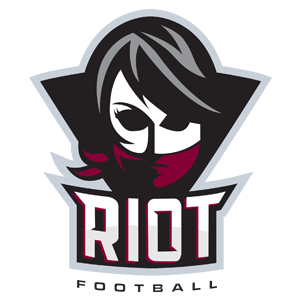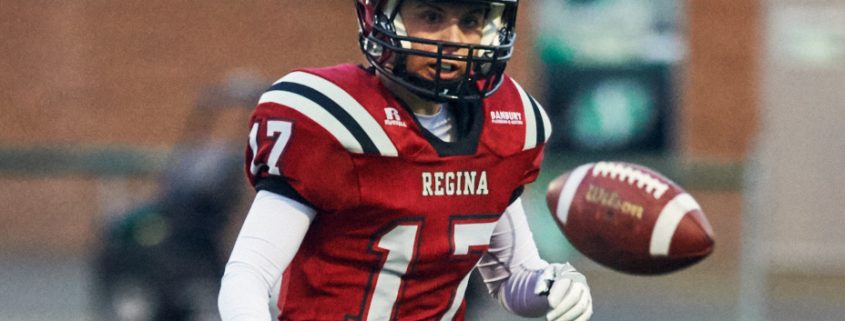10 QUESTIONS WITH MIRA TREBILCOCK
In the lead up to the 2018 regular season, we’ll be taking a closer look at certain Regina Riot players both on-and-off the field in our new series, 10 Questions. In our final instalment, we learn more about defensive back Mira Trebilcock.
- You are a hockey player who decided to start playing football. What was it about football that made you want to pursue that as well?
I had spent 4 years in the Chicago, Illinois attending university and playing NCAA hockey and soccer. Upon graduating it became clear that there are very few opportunities for women to continue competing in elite sports, especially in Western Canada. I was excited to try football, a staple within the American culture, yet something I never thought I would have the opportunity to play. Originally, I joined the Riot to learn a new sport and to be able to compete at an elite level again. I’ve since learned that football is one of the most dynamic sports, from the depth of the playbook to the breadth of the players who play the game. Moreover, I am very proud to be a member of the Riot, as female athletes I think it’s part of our responsibility to serve as positive ambassadors and leaders for young females in our community. Young girls can grow up watching and learning that their passion for sport is encouraged, even stereotypical ‘male’ sports like football.
- What is the biggest difference between playing hockey and playing football?
On the surface, almost everything is different. After all, one sport is played on ice and the other is played on a big grassy field – with the most obvious difference being the fact that football requires hitting, something that is penalized in women’s hockey. But, as I continue learning more about football some striking similarities have emerged. Hockey and football both require spacial recognition, anticipation, physicality and aggressiveness. Players on both sides of the ball have certain responsibilities depending on their respective positions and strategic efforts are used to score and prevent the other team from scoring points.
- You’ve been starting at safety for the Riot for a number of years. What is the biggest challenge of playing the safety position?
I am very fortunate that I had the opportunity to play safety in my very first season in 2015 and continue in that same position 3 years later. It’s a fun position. I think the biggest challenges are awareness and adaptability. Awareness of what’s happening on the field, with the opposition and with your own defence – and then being vocal about it. Everyone is in front of you – you’ve got to be confident and knowledgeable about what you’re seeing. No matter the defensive scheme, being smart and athletic has certainly made it easier to adapt if a play call is missed or something unexpected happens – as a safety you can be an athlete and make plays. The more a safety knows about the game, including technical terms, coverages, technique – even overall about positions of our team defence, from the linewomen, linebackers and defensive backs – the more reliable she can be, and the more likely she is to help her team succeed.
- Tell me about an interception of yours, or perhaps a near miss, that sticks out in your memory since joining the Riot.
There are 2 that stick out:
One was a terrible miss, in the final regular season game against the Wolf Pack in 2015, their quarterback threw a deep ball and I was in perfect positioning, literally all I had to do was catch it. Instead, the ball rattle first off my hands, then head, then chest and even feet – it hit every part of my body. We were already up a considerable amount at that point in the game, so it provided some comedic relief for everyone, but it certainly made me practice my catching a little more, which has helped in bringing in more interceptions since.
The second was an interception against the Fearless in a conference semi-final game in 2015. The play before the interception we had executed a ‘spin’ on defence perfectly resulting in a big hit and some yards lost for their offence. The next play they threw it up and I was able to bring it in and return it in for a pick-6 and the first touch-down of the game/of the 2015 playoffs. I thought it helped me redeem the comedy of that ball hitting every part of my body.
- If you could only pick one player as the funniest on the entire team, who would it be?
There are a lot of different personalities on our team that contribute to the unique dynamic we have. I always look to Stacey, Turner or Jenna to keep things light or to get a good laugh in at practice, even between plays.
- Explain to me the camaraderie and friendship that develops on a team like the Riot.
Winning teams have a well-honed sense of camaraderie that helps team members read one another’s signals, move as one, and watch each other’s back. Players on the Regina Riot are very welcoming, and happy to help one-another other learn the game and grow as players. This attitude helps to cultivate a strong sense of affiliation and pride, which ultimately makes team members of the Riot feel a shared sense of commitment and connection – it’s a culture we want to continue building stronger every year. My teammates and coaches have become some of my closest friends, leaders and mentors. We joke around that the Riot is your second family, because during season you spend so much time together. I think when the Riot is the most successful is when we share a deep sense of affiliation and friendship on and off the field. The more people value their relationships with one another, the better they will perform for one another and thus the team as a whole.
- How do you like to spend your time when you aren’t playing hockey or football?
When I am not playing football or hockey I work as a Development Officer for the Hounds at Athol Murray College of Notre Dame in Wilcox, SK. I help to build and facilitate the relationship between the high school and its vast community to help fundraise for the college. I am also working to complete my Master of Science in Sport Management at the University of Regina. I am a huge advocate for athletics and growing the game, especially for female athletes so I try to help out with the Female Midget AAA hockey team at Notre Dame any chance I can. With a hectic schedule, I do value any chance I get to spend with those closest to me, my family and friends -whether it’s a weekend brunch or catching up while playing on the ODR.
- What is your favourite moment in a Regina Riot jersey?
June 28, 2015.
- How has playing for the Riot helped you grow as a person?
Being part of a team is about being a part of something bigger than yourself. As much as I love to win and simply be competitive, it’s the notion of being able to challenge myself in a different area of my life, and make myself just a little bit uncomfortable that has provided me with great opportunities to develop on and off the field. Playing for the Riot has been a privilege that has positively impacted many areas of my life, helping me grow as an athlete, a professional and a steward within the community.
- Where do you think the Regina Riot are headed in 2018 and beyond?
The Regina Riot have seen immense growth, even throughout the three, going on four years I have been involved with the organization. Winning two championships certainly helps to establish the success of the program but it also cultivates a culture that people want to be a part of. It’s helped us recruit more athletes and more coaches with very diverse and experienced backgrounds who share the same values and goals that we aim to fulfill. It’s helped us form partnerships with medical staff and local organizations like Ovarian Cancer Canada, Mr. Mikes, AGT Foods and Evolution Fitness.
Through these partnerships and our involvement in the community, the Regina Riot is certainly becoming a familiar name that carries very positive connotations. The Riot acts as a powerful platform that unifies tenacity and drives action for female athletes in a sport that shares the exact same rules, regulations and equipment as the male version of the sport – the only difference is the gender of the athletes who play it. I think the Riot drives action for gender empowerment while celebrating the social and cultural achievements of athletes, coaches, business people and students within our community. I believe there is a very bright future ahead for the team and all those involved with it – beginning with a back-to-back championship in 2018.




Leave a Reply
Want to join the discussion?Feel free to contribute!